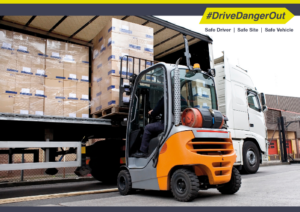The Health and Safety Executive for Northern Ireland will focus on the safe loading and unloading of vehicles in the haulage and logistics sector as part of its recently launched ‘Drive Danger Out’ workplace transport safety campaign. The focused inspections are now underway and will continue until March 2024.
HSENI Principal Inspector (Transport Team), Kellie McNamara said: “Loading and unloading of vehicles can be a particularly hazardous activity regardless of the size of the business. We see incidents involving people falling from height including from flatbed trailers, being struck by a vehicle, or moving equipment, and from being struck by falling objects.
 “While the management of loading and unloading forms part of our regular inspections, over the next few months we will be placing a particular emphasis on this area of work in a positive move to reduce the number of people killed and injured in the sector.”
“While the management of loading and unloading forms part of our regular inspections, over the next few months we will be placing a particular emphasis on this area of work in a positive move to reduce the number of people killed and injured in the sector.”
Businesses are being asked to ensure there is always adequate provision to allow for safe loading and unloading especially in relation to uneven loads which can result in a vehicle or trailer becoming unstable.
Ms. McNamara added: “Companies must have clear signage and instructions for logistics and transport driver arriving at their site. In addition, drivers should always be provided with a safe place to wait which is located away from moving vehicles and handling equipment, while their vehicles are loaded or unloaded.”
 The Management of Health and Safety at Work Regulations (Northern Ireland) 2000 requires all loading and unloading activities to be risk assessed and performed by trained staff who are aware of the risks involved. Drivers should also be aware of the risk of the load, or part of the load, moving when the vehicle is in transit.
The Management of Health and Safety at Work Regulations (Northern Ireland) 2000 requires all loading and unloading activities to be risk assessed and performed by trained staff who are aware of the risks involved. Drivers should also be aware of the risk of the load, or part of the load, moving when the vehicle is in transit.
Inspectors will consider key questions, including:
- Are there specific areas for loading and unloading of vehicles, which are segregated from pedestrians and traffic, on level ground, well-lit and protected from adverse weather?
- Is there a safe area where drivers can observe loading, when necessary, or to rest whilst the loading and unloading activities are completed?
- Is there clear signage and instructions for drivers coming into your site who may not be familiar with the surroundings / site specific procedures?
- Are there sufficient measures in place to prevent vehicles being driven off during loading or unloading activities?
- Are loads suitably secured and have checks in place to ensure they are in good condition?
- Are tipping operations performed on level ground away from overhead obstacles with the tractor and trailer units of articulated vehicles aligned?
- Is work at height avoided when performing sheeting or the strapping of loads (including flatbed lorries)? If that is not possible what controls are in place in terms of fall prevention?
During inspections, should significant risks be identified, Inspectors may take enforcement action to achieve compliance with health and safety legislation to ensure that the risks are adequately managed and reduced as far as is reasonably practicable.
For more information, visit: www.hesni.gov.uk/workplacetransport















